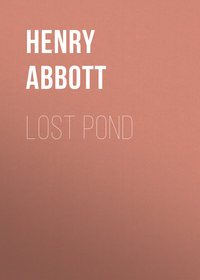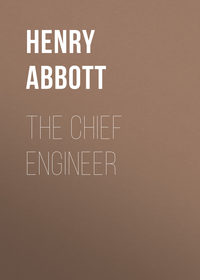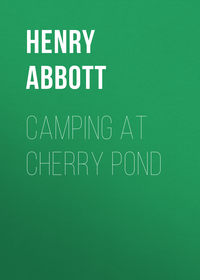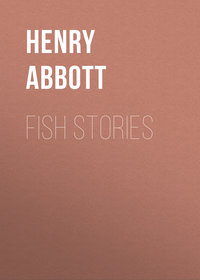 полная версия
полная версияCamps and Trails
This trail making incident occurred fourteen years ago. It serves to indicate how easy it is for one to go astray in a large forest. I have since blazed many trails in the woods. I have also, many times been misplaced in the forest while hunting or exploring and am always on such occasions reminded of Bige's advice to "never argue with your compass while in the woods." Whenever my compass tells me that camp is in a direction opposite to that which reason and memory and the lay of the land indicates, my practice is to sit down on a log, lay the compass on the log, stand the gun up against a tree far enough away so the steel of its barrel will not influence the compass needle and try to arrange in mind the topography of the country I am in. After a reasonable rest I am always willing to follow the pointing of the compass at least for a limited distance.
The first impulse of one who thinks he is lost in the forest is that of haste. One is always in a desperate hurry to get somewhere quick. If this impulse is obeyed and the now alarmed traveler rushes off at headlong speed, the danger is, not only that of going in the wrong direction, but in nine cases out of ten, the victim travels in circles. The psychology of deliberation is like first aid to the injured and the victim soon begins to realize that he is not really lost. He is only temporarily mislaid and will soon pull himself out and locate some familiar landmark.
The "Davy Crockett Camp" we built on a narrow shelf on a steep hillside. It overlooked "Muskrat City" which lay in the valley directly in front and below our open "lean-to." We were well pleased with the result of our efforts in the construction of this forest boarding house. It had a fireplace in front for heating the camp and a cooking fireplace at one side. This arrangement kept the cooking odors out of our camp blankets and clothing. We also had a dining table and a kitchen table, both made of split logs. The water was good and the entire outfit comfortable. Moreover, we generally had good luck in hunting while there.
The best way to reach Davy Crockett's was to go up the river about seven miles, then take the "Elk Pond Tote Road" back through the woods five miles to Muskrat City. We also sometimes used another route which was shorter but more difficult. This was by way of Dan'l Boone's; from which point we had cut a trail down the valley and over the western end of Crescent Mountain.
Several times I tried to get a photograph of the Crockett Camp. Because of its location I could get no standing room for a front view. If the camera was placed up the hill back of the camp the picture would show only the roof. One day I climbed a tree with the camera and took a snap shot at the side. The artist spoiled this film in developing. The following winter, six feet of snow broke down the roof and in a wind storm a large tree fell across it and smashed the shack. It was not rebuilt and I never got a picture of the Davy Crockett Camp.
We once set up a tent alongside the "Cherry Pond Camp" and for a week, entertained there a party of six hunters and four guides. It proved to be a strenuous business to provide enough food for ten husky appetites. However, they all expressed the wish that they might come again; we therefore, concluded that they were not sent away very hungry.
The "Cedar Lake Camp" on the shore of that lake, was in a good fishing region. It was a starting point as well, for exploring trips. Through the waters of that lake and its many tributary streams with short carrys to other lakes and ponds, we could make long excursions by boat.
The "Buck Mountain Camp" was at first a cabin similar to Danl's. Later we built an open camp addition which we used for sleeping quarters during the summer but we usually slept in the cabin in cold weather. A short distance from this camp was "The Anxious Seat" which has been fully described in another story.
One day while staying at this camp I was hunting in the valley north of Parker's Pond. Had just crossed a beaver meadow and entered a thicket of balsam and cedar trees, when I came upon the saddest and most distressing sight I have ever witnessed in the woods. Under the shelter of these evergreen trees in a space perhaps twenty yards in diameter, I counted the bleaching skeletons of seventeen deer. Eight of these were small, evidently the bones of young animals, less than a year old. The ground within this space was trampled hard and bare of green vegetation. Witch hopple bushes had been pulled up by the roots and the larger stems and branches stripped of twigs were left lying on the ground. Ground hemlock had been skinned of everything except the main stems. Even the bark was gone. The lower branches of the trees, balsam, cedar and a few hemlocks to a height of seven feet from the ground were stripped bare of twigs and bark. A fallen and rotting hardwood tree lay partly within the circle of death. Beyond the bone yard, this tree trunk was covered with a heavy coating of moss. Within, it had been scraped and gnawed. Starvation was written in large letters all over the place.
In summer time the deer find food in plenty everywhere; and in great variety. In winter their diet is more limited as to variety but they can always find enough food if they are able to move about. Deer can manage fairly well even in deep snows, so long as the snow remains soft. They also have been seen traveling on a hard crust formed on top of four or five feet of snow. But when the crust is thin and the deer breaks through, the thin sharp edges of icy crust cut his legs and a bloody trail marks the path of his floundering until, discouraged, he returns to the "yard" in the evergreen thicket, where he, and a number of his fellows herd together for protection from the cold winds of our northern winters. Within this yard the animals move about and pound down the falling snow, while outside, the drifts grow deeper. Here, when the crust had formed on the snow and every green thing within easy reach had been eaten, the deer stood upon his hind legs, stretching his long neck to its utmost length and reached into the lower branches of the overhanging trees for a mouthful of browse. When the last scrap of brush had been devoured, too weak to longer stand, he lay down to await a slow and lingering death by starvation. And when the last feeble blat of the last surviving member of the herd trembled on the frosty air, the curtain fell on the saddest of all woodland tragedies.
Every summer we find it necessary to cut out trees which have been thrown across our trails by storms of the previous winter. Sometimes, the limb of a tree falls through the roof of one of our camps, making repairs necessary. Occasionally, in our absence, a porcupine gnaws our rustic camp stools or eats up the dining table; now and then, some animal friend steals our food, but these are minor troubles that are easily cured or provided against.
A few times, other people have used our camps, but these, if they are real woodsmen and know how to use a camp, are always welcome. To such, "the latch string is always out." But the animal we most fear, indeed the most destructive animal that ever enters the woods, is the picnicker. His bump of destructiveness is, if one may judge by his works, abnormally developed. He is never constructive. He calmly makes use of the works of others without ever saying, by your leave. Seemingly, he is never happy, unless he is tearing down something that others have painstakingly and laboriously constructed.
When your picnicker enters a camp, he burns up the firewood if any has been left there, and he always uses the balsam boughs of the camp bed for kindling. Also, he uses a lot of it for fun, just to see it blaze up high and throw out sparks. He never has been known to cut firewood. He has no axe and wouldn't know how to use an axe if he had one; so when he arrives at a camp, if no wood is found ready to hand, he burns up the rustic seats. Next he burns the slats of the bed, then the camp table, then a part of the frame or roof timbers of the camp. When he departs the ground is left strewn with scraps of the late meal, lunch boxes, newspapers, tin cans and other refuse. After a few visits of picnic parties the camp is a complete and hopeless ruin.
A few years ago, George and Leslie built a camp for Judge Bowles. It was located at the place where the trail to Bald Mountain Pond crosses High Ball Brook. The camp had a frame made of saplings that was covered with tar paper. It had a good bed, rustic table with bark top, seats, fireplace, etc., and was, in every way comfortable. The Judge and his friends stayed in his camp one night. After that, whenever he visited the place, he found it occupied by a picnic party.
The trail to Bald Mountain Pond was marked many years ago by the Indians. It is now a well beaten path, known and used by Summer residents and boarders along both shores of the lake through fourteen miles of its length. They came in motor boats, in parties of four, of six, of a dozen, and twenty-five or thirty at a time. It was a short and easy walk of a half an hour through the woods to the camp. The picnickers did the rest. The two pictures "before" and "after" herewith, show what happened in one short season to the Judge's camp.
Most of the camps that Bige and I have built, are too far from the main lines of motor boat travel, and they require the expenditure of too much effort to reach them, to make them attractive to the average picnicker. Yet, mindful of the fate of the High Ball Brook Camp, we have in some cases thought it wise to camouflage the trail. Many novel and some ingenious devices have been employed to this end.
One misguiding scheme, we successfully practiced as follows. At a place where the trail should, properly, describe an elbow or a curve, the blazing of trees would continue on in a straight line, leading possibly over a hill or down through a swamp where it would peter out and end in nothing. Then returning to the elbow or turning point, the real trail would be marked by taking bunches of moss off the hardwood trees and nailing them onto balsam or spruce trees. This practice would be followed for fifty yards or more, when the blazes would begin to appear again. Of course, an old and experienced woodsman, if he were suspicious of a trick, would never be caught by this one; as he would know that moss never grows on a live spruce tree, except in small patches near the roots in a wet or swampy place, while an entire Russian beard of moss can be seen anywhere on beech, maple or birch trees. Indeed, at the place where we thus marked our trail, one could, without moving a step, count twenty or more similar bunches of whiskers on as many hardwood trees within his range of vision. However, the picnickers never got by.
The struggle for existence, the elbowing, pushing and crowding of individuals, and the final survival of the stronger, the more fortunately placed, or the one who arrived and got established first, is nowhere in nature more marked or more conspicuous than among forest trees. The weaker ones die before they mature, because there is not "room in the sun" for the branches of all; and because, as the roots develop and increase in size, there is not enough room in the ground for the roots of all. Also, there is not enough plant food in the soil to sustain life in all the trees that get a start in the forest. Hence, it is, that in the older woods one can always find, still standing but dead and dry, half grown trees of all kinds. Of these, the hardwoods make the very best fuel for campfires. And a dead spruce six to ten inches in diameter makes excellent logs for building an open camp or a cabin. The smaller dry spruces, three to four inches in diameter, make better roof timbers than do green ones. But they must be taken while standing. A tree lying on the ground in the shade, absorbs and retains moisture and it soon decays and is unfit for use for any purpose. Thus, while conserving live forest trees, one may obtain material better suited to his purpose than if he had used green timber having a market value.
The State owns more than two million acres of forest land in the northern mountains. A few years ago, it was permissible to build log camps on State lands. Recent laws forbid this, and now camping on forest land owned by the State is limited to the use of tents.
Now, when Bige and I decide to build a shack we select a spot on some lumber companies' property and then try to get from the owners, permission to build. Such a permit is usually not difficult to get, but one must always furnish evidence of his knowledge of woodcraft, especially of his ability to so construct a camp fireplace as to prevent the fire spreading to the woods and thus destroying a lot of property.
"The Trout Hatchery Camp" is of this class, the owners only reserving the right to use the camp for their own employees in case of need. I believe that in a period of five years they have so used it only twice. On one occasion a party of surveyors, who were correcting and reblazing the boundary line of the companies' property, spent a night in the camp. On another occasion some men were sent over the mountain from headquarters to put out a fire about a half mile from The Hatchery. This fire had been started by a careless cigarette smoking hunter who threw a burning cigarette butt down in the dry leaves.
The Hatchery camp was built by Bige and Bill at a time when I was carrying about with me a rather complicated harness in which was a broken arm; so, I had no hand in its construction, but I contributed a lot of advice. I have found it a very comfortable living place.
It has for many years been our practice, on occasions when we happened to have a good supply of game in the cooler, to go back to the cottage by the lake, collect our women folks and lead them over the trail to camp, where we would give them an exhibition of real camp cookery; while we roasted a saddle of venison before the campfire, serving it to our distinguished guests while they sit upon logs around our rustic camp table in the shade of the towering forest trees. Thus do we square ourselves, justify long absences and gain new indulgences.
There is a wonderful spring at The Hatchery. The water is very cold and there is a large volume of it boiling out of fissures in the rocks on the mountain side. Indeed it is the beginning of a fair sized brook which tumbles over the boulders and swiftly rushes along its gravelly bed just back of the cabin. By its music we are lulled to sleep at night and it is the first sound to greet us at day break.
Bige allowed that it was a great pity that there were no holes in that brook with water deep enough for trout to live in as the water was ideal for that purpose. Trout are fond of cold spring water. They flourish best in it. Besides, the nearest trout brook was two miles away, and sometimes, during the open season, we need fish. So, said we, "let's make some holes."
Immediately, we got busy building a dam across the stream near the shack. We employed some of the methods of Brother Beaver, which, though primitive, are none the less effective, and we soon had a pool of water from three to four feet deep, seventy feet long and twenty feet wide at the dam. Then selecting our smallest hooks, we filed off the barbs and went down to Pickwacket Brook where we caught some trout which we kept alive and brought back in a bait pail. Many and frequent changes of the water were necessary to keep our fish alive, but they were safely deposited in the pool.
Then, a more pretentious plan was devised and in carrying it into effect, we built other dams, five in all, with stretches of swift water between. Gravelly and sandy spawning beds were provided in the shallow water. Overflow or spillway places were made on one end of each dam, so that the fish might freely pass up or down from one pool to another. Stones and overhanging banks made suitable hiding places for the shyest and most wary fish known to anglers. In short, we reproduced as nearly as possible the most favorable conditions for the natural propagation of brook trout.
Many fishing trips were made before we considered our hatching ponds sufficiently stocked. At first we fed our fish daily, but we soon learned that they had natural food in abundance and that they preferred it to what our catering provided.
During three summers that our experiment in pisciculture has been in progress, not the least of the pleasures of life at Camp Hatchery, is found in watching the spawning beds, observing the play of schools of fingerlings, or lying on the shore of one of the pools in the evening twilight, to see the larger trout jump clear above the surface and grab a passing fly or moth.
Enemies of the brook trout, neither those of the two-legged nor those of the four-legged varieties have yet seriously raided our fish farm. Individuals of the original planting have now developed into the most desirable sizes for table use. And it is now possible for me, in the morning while Bige is lighting the camp fire, to take a fly rod, go twenty yards back of the cabin to one of the pools and by the time Bige has the coffee made and the bacon cooked, have my breakfast trout caught, dressed, and in the frying pan before they have finished flopping.
END OF CAMPS AND TRAILS







